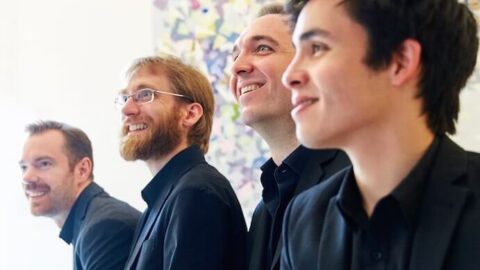“Explosive virtuosity”
“Mind-blowingly good”
“Among the most stimulating new-music concerts of my experience”
Though there are countless other quotations like these from the Boston Globe, LA Times, and Philadelphia Enquirer in praise of the JACK Quartet, the ensemble seems to spend little time reflecting on their hard-earned achievements. Instead, they are embarking on an ambitious project called Soundscape America, for which they will survey contributions to the string quartet literature by American composers from the twentieth and twenty-first centuries. The quartet will perform a total of 11 works over the span of two evenings on October 19 and 21 at the Miller Theatre at Columbia University. The program reflects the breathtaking variety of styles and periods in the American string quartet repertory, ranging from Ruth Crawford Seeger’s String Quartet from 1931, to John Zorn’s Necronomicon from 2003, to a significant body of works from the last decade. In addition to the two performances on Thursday and Saturday, the JACK Quartet will join two of the featured composers—Erin Gee and Marcos Balter—for a conversation on Friday, October 20.
Soundscape America is a remarkably ambitious project; how and when did you decide on it?
JACK has a rich history with Miller Theatre. They’ve inspired some of our richest collaborations and most enlivening concerts. Just last week, we sat down together and re-watched Simon Steen-Andersen’s incredible Run Time Error videos made at Miller over the course of a week, and last month we recorded a quintet by Hannah Lash that we premiered on the Miller stage. Our artistic projects and collaborators are consistently fueled by the engine of Miller’s adventurous programming of new music, especially American music. So when they approached us about designing two programs of American music for string quartet, we knew we had a broad playing field to explore with trusted teammates. The process was long and changed shape gradually over the last year. On a personal note, it was the first major project that the new configuration of JACK began working on together last fall.
There are an astounding number of wonderful string quartets by Americans written during the twentieth and twenty-first centuries; what was your process for choosing which works to perform?
The four of us spent months brainstorming works from the past century that best tell the story of American composition. Our list was growing endlessly, so we had an idea to focus on works that complement each other, creating connections between the two programs. For instance, some of the works are theatrical in nature (Diels and Applebaum), while others follow in the lineage of American modernism (Seeger and Carter) and improvisation (Braxton and Zorn). We wanted to feature works by composers we’ve looked up to throughout our growth as musicians while also featuring emerging artists who we feel are changing the course of American music today, so these programs span several generations of compositional voices.
As an ensemble you’ve performed and recorded music from a very broad range of musical styles; how do you prepare to engage such a wide range of musical languages over the course of two evenings?
Step one with JACK is that we try to be game for whatever no matter what’s asked of us in terms of musical style, seemingly extra-musical elements, or technique on our instruments. We want to have a collectively open mind to the possibility that we can make any compositional or interpretive idea work, no matter how little we understand it initially or how ill-equipped we are to achieve its ends on first glance. We try to develop strategies, rehearsal methods, and ways of being that enable us to embody anything that’s asked of us, and sometimes we can only find that inspiration through working with the composer directly. Other pieces invite us into a rich labyrinth of choices that we feel comfortable making without guidance. One element of the programming choices within these concerts is the sheer variety of musical demands at play. We court this variety and try to develop our process as a quartet to manage this diversity of style and manner.

Has your preparation of these works led to any new insights into the trends or dissimilarities among American string quartets that you can share?
Trying to force the narrative around the American string quartet into one coherent stream of thought is simply impossible. We’re not trying to make an effort to do that in these programs. Our hope is to provide some windows into the tall apartment buildings and small family homes full of creative voices that are in neighborhoods where our friendly concert-goers might not frequently travel. Perhaps we can convince them to take an extra stop on the train and have a drink at the corner bar with the locals, people whose experience and ways of seeing the world expand what seemed possible before.
Is there anything you’d like to communicate with attendees about how they should approach these concerts as listeners?
Why do we like to sit down to a concert of four people playing stringed instruments together? Should we be pleased by their sounds? Should we be impressed by their technical mastery or musical command? Should we honor the voice of the composer and become enraptured in their vision of musical expression or anti-musical protest? What does it mean to come together as four people and try to share a unified concept of a piece by yet another musician, the composer? Is there something beyond the sounds themselves? Is America nothing more than a collection of individuals, or do we come together in our din of voices and say something together? What about within our small field of music that can be presented in a concert hall on an elite university campus? What are we talking about? Who’s driving the conversation?
























